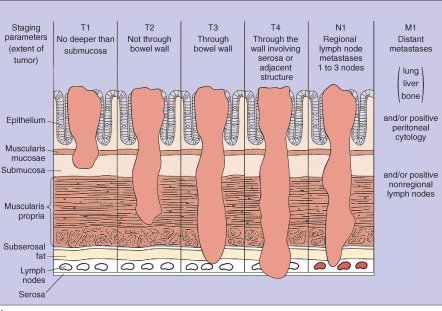Rectal Cancer
Overview
Surgery is a common treatment for rectal cancer. The type of operation used to remove the rectal cancer depends on the extent and location of the cancer. If the rectal cancer is located well above the anus, a low anterior resection (LAR) can be performed. This operation allows the patient to keep anal function and pass stools in a normal manner. If the rectal cancer is located close to the anus, sometimes the anus must be removed with the cancer in an operation called an abdominoperineal resection (APR). The patient must then use a permanent colostomy bag. A colostomy is an opening where the large intestine is attached to the abdominal wall. A replaceable bag that encloses the colostomy is worn by the patient to collect stool.
Low Anterior Resection Surgery (LAR)
LAR is a common treatment for rectal cancer when the cancer is located well above the anus. During a LAR, the entire rectal cancer, adjacent normal rectal tissue and surrounding lymph nodes are laparoscopically removed through small incisions on the abdomen and then brought out through an incision made in the lower abdomen. After the cancer is removed, the cut ends of the colon and rectum are stapled or sewn back together. The passage of stool from the large intestine through the anus is therefore preserved.
If the cancer is lower in the rectum, the cut end of the large bowel may be attached directly to the anus, a procedure known as colo-anal anastomosis. When a colo-anal anastomosis is performed, some surgeons will create a temporary ileostomy or colostomy in order to protect the delicate surgical connection of the large intestine to the anus. After the patient has recovered from the surgery, the temporary ileostomy or colostomy is removed and stool is again passed normally through the large intestine.
Despite undergoing complete surgical removal of rectal cancer, some patients may experience recurrence of their cancer. It is important to realize that some patients with rectal cancer already have small amounts of cancer that have spread outside the rectum and were not removed by surgery. These cancer cells are referred to as micrometastases and cannot be detected with any of the currently available tests. The presence of these microscopic areas of cancer causes the relapses that follow treatment with surgery alone. External beam radiation therapy and chemotherapy can be used to cleanse the body of micrometastases in order to improve the cure rate achieved with surgical removal of the cancer.
Patients undergoing an LAR may experience lower abdominal pain after the operation. Less common complications related to surgery include bleeding, infection and temporary difficulty with emptying the bladder. Some men may experience sexual dysfunction after surgery.
Abdominoperineal Resection Surgery (APR)
APR is a common treatment for rectal cancer when the cancer is located close to the anus. During an APR, the entire rectal cancer, adjacent normal rectum, rectal sphincter or anus, and surrounding lymph nodes are removed through an incision in the lower abdomen and the perineum (the skin around the anus). Following removal of the cancer, the incision in the perineum is sewn shut. The cut end of the large intestine is attached to an opening in the abdominal wall, called a colostomy. This opening is covered with a bag, which serves to collect stool as it passes through the large intestine and through the colostomy. In contrast to a LAR, the colostomy is permanent.
Many patients would like to avoid a permanent colostomy. When the rectal cancer lies close to the sphincter or anus, an APR is typically recommended. In some instances, a more limited surgery can be used to avoid a colostomy, or radiation therapy can be used to shrink the rectal cancer prior to surgery allowing the patient to maintain control of bowel function. Some small rectal cancers that lie close to the anus can be removed with less extensive surgery called a local excision. Not all patients can undergo a local excision (see Local Excision below).
Local Excision
Limited surgery can be performed to remove the cancer and preserve the anus and prevent the complications that may occur with more extensive LAR or APR surgeries. The limited surgery is designed to remove the cancer and a small rim of normal bowel, but not the anus. The surgery may be performed through the anus (transanal excision). A transanal excision can be performed for small cancers that lie close (typically within 2 inches) to the anus.
For limited surgery to be effective, the entire cancer with a rim of normal tissue must be removed. Patients with cancers that are larger, more deeply invading, or appear aggressive under the microscope are better treated with traditional surgery. In order to improve the cure rates after limited surgery alone, a combination of chemotherapy and radiation therapy is often administered for cancers that have grown into the muscular wall of the rectum.
Patients undergoing limited surgery may experience pain in the region of the perineum or tailbone. Less common complications related to surgery include bleeding, infection, and difficulty with healing of the rectal wall. In-hospital fatality is very rare after limited surgery.
Strategies to Improve Treatment
The progress that has been made in the treatment of rectal cancer has resulted from improved surgical techniques and the development of neoadjuvant and adjuvant treatments in patients with more advanced stages of cancer.
Improved Sphincter-Sparing Treatments: Because of the inconvenience of a colostomy, physicians are using sphincter-sparing treatments that allow patients with low-lying rectal cancers to keep the anus. Improved methods to select patients who can be treated with limited surgery followed by adjuvant chemotherapy and radiation therapy are being developed. More aggressive use of preoperative (neoadjuvant) chemoradiation may allow more patients with larger low-lying rectal cancers a chance to maintain anal function.
Neoadjuvant Therapy: When rectal cancer cannot be completely removed with surgery, a patient’s chance of cure is greatly diminished. Presurgery radiation and/or chemotherapy is referred to as neoadjuvant therapy. Neoadjuvant therapy can shrink some rectal cancers and therefore allow complete surgical removal. Determining the optimal neoadjuvant chemotherapy and radiation therapy is an area of current research.




